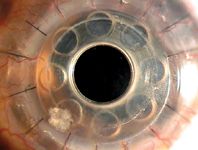Article
Artificial cornea useful in patients with multiple graft rejections
In patients who have suffered multiple immunologic graft rejections, the chance of providing good-quality vision is dramatically increased with a keratoprosthesis than another transplant. Patients who receive a keratoprosthesis have rapid visual return, a good quality of vision, and a high rate of graft survival.

Key Points

Dr. Belin said that he has been using the device for about 5 years.

Visual rehabilitation is faster with the device than with repeated keratoplasty, Dr. Belin added, because astigmatism is not associated with it.
The potential drawbacks associated with implanting an artificial cornea are similar to those associated with any transplant, he said.
"Any transplant, particularly repeat transplants, have an increased risk of inducing glaucoma or a pressure problem, and it's conceivable that the donor rim can melt as a transplant would melt," Dr. Belin said. "But the prosthesis is extremely well-tolerated by the eye."
Patients who receive the prosthesis generally are kept on anti-inflammatory and anti-infective therapies postoperatively, he said.
Graft survival rate
Albany Medical College's Division of Cornea & Refractive Surgery serves as the data collection site for the ongoing international study, which is co-chaired by Joe Ciolino, MD. So far, in about 250 eyes, the study has demonstrated a graft survival rate of more than 95%.
"If we look at the subset of just patients with immunologic graft rejection, not ocular surface disease, [that rate is] about 98%," Dr. Belin said.
Patients who receive an artificial cornea can expect good visual outcomes from the device itself, although their vision still may be limited because of other problems within their eyes.
"The device itself is capable of providing 20/20 vision," he said. "What limits vision is not the device but usually the associated ocular conditions.
"Most patients who have had multiple, multiple grafts have other conditions such as cystoid macular edema, retinal changes, glaucoma, and nerve damage," Dr. Belin said. "The device itself is a clear, plastic device with perfect optics, so the limiting factor is usually not the device. It's what else is really going on inside the eye."
Newsletter
Don’t miss out—get Ophthalmology Times updates on the latest clinical advancements and expert interviews, straight to your inbox.




